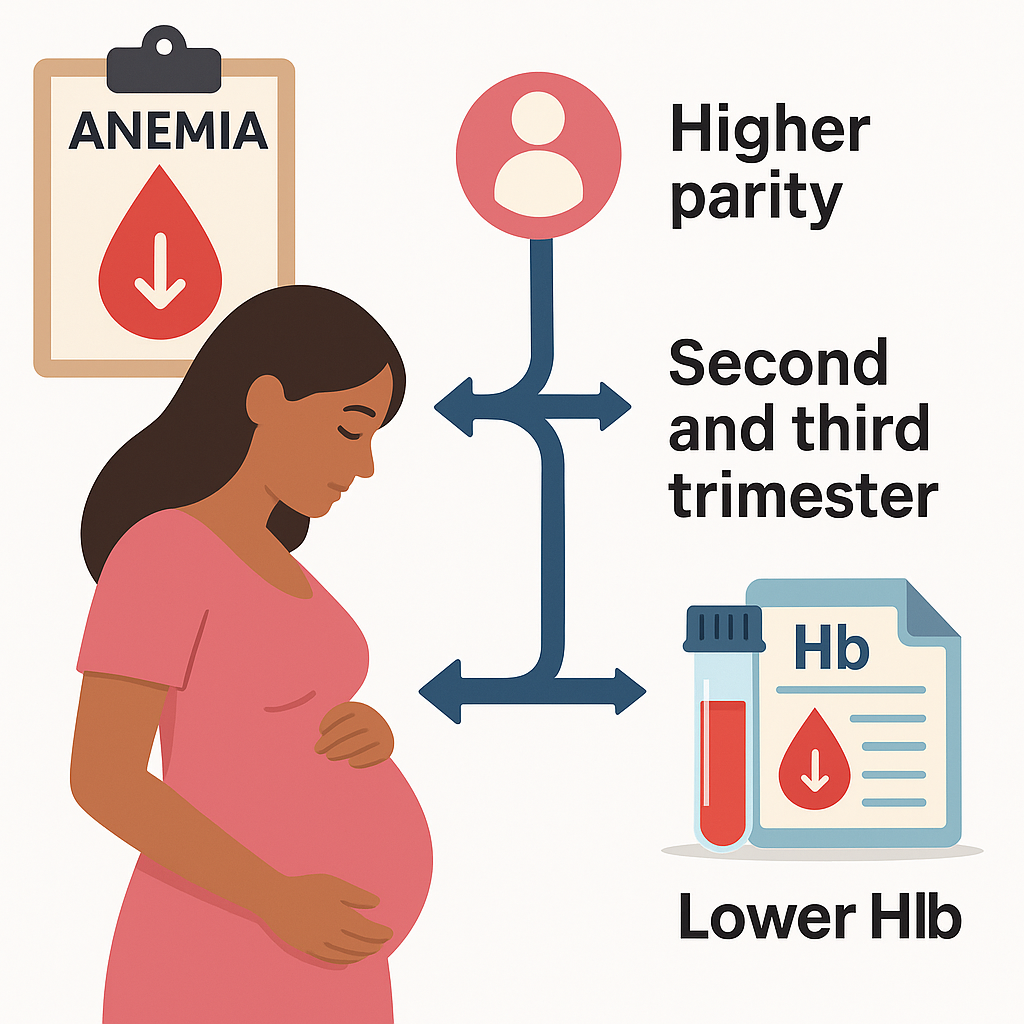Parity is Related to Anemia in Pregnant Women in the Coastal Area
https://doi.org/10.33860/jik.v19i1.3122
Keywords:
Anemia, Pregnant women, Parity, Gestational ageAbstract
Maternal mortality is still a serious problem in Indonesia. One of the causes is anemia in pregnant women. Anemia in pregnant women is very influential not only on the mother, but on the fetus, and the process of childbirth. The purpose of the study was to analyze the relationship between parity, gestational age and the incidence of anemia in pregnant women in coastal areas in Soropia sub-district, Konawe Regency Design Method of analytical observational research with cross sectional design, sample selection with purposive. The population of all pregnant women in Soroia sub-district. Large sample of 38 respondents, variables of parity study, gestational age and anemia. Questionnaires and Hb check tools were used to measure the variables of parity, gestational age and Hb respondents. Chi-square statistical analysis with α = 0.05. The results showed a significant relationship between parity and anemia in pregnant women (p = 0.036). Pregnant women in the 2nd and 3rd trimesters were more likely to have anemia than pregnant women in the 1st trimester, although the relationship was not significant (p = 0.12). Conclusion. The more parity many tend to be anemic and the closer to birth the Hb decreases.
References
1. Chaparro CM, Suchdev PS. Anemia epidemiology, pathophysiology, and etiology in low- and middle-income countries. Annals of the New York Academy of Sciences. 2019 Aug;1450(1):15.
2. Riskesdas 2018 Team. National Report of Riskesdas 2018. Jakarta: Health Research and Development Agency (LPB) Publishing Institute; 2019.
3. Allen LH. Anemia and iron deficiency: effects on pregnancy outcome123. The American Journal of Clinical Nutrition. 2000 May 1;71(5):1280S-1284S.
4. Mbule MA, Byaruhanga YB, Kabahenda M, Lubowa A. Determinants of anemia among pregnant women in rural Uganda. Rural Remote Health. 2013;13(2):2259.
5. Black RE, Victora CG, Walker SP, Bhutta ZA, Christian P, de Onis M, et al. Maternal and child undernutrition and overweight in low-income and middle-income countries. Lancet. 2013 Aug 3;382(9890):427–51.
6. Stevens GA, Finucane MM, De-Regil LM, Paciorek CJ, Flaxman SR, Branca F, et al. Global, regional, and national trends in hemoglobin concentration and prevalence of total and severe anemia in children and pregnant and non-pregnant women for 1995–2011: a systematic analysis of population-representative data. The Lancet Global Health. 2013 Jul 1;1(1):e16–25.
7. Kidanto HL, Mogren I, Lindmark G, Massawe S, Nystrom L. Risks for preterm delivery and low birth weight are independently increased by severity of maternal anemia. S Afr Med J. 2009 Feb;99(2):98–102.
8. Levy A, Fraser D, Katz M, Mazor M, Sheiner E. Maternal anemia during pregnancy is an independent risk factor for low birthweight and preterm delivery. Eur J Obstet Gynecol Reprod Biol. 2005 Oct 1;122(2):182–6.
9. Ministry of Health. Efforts to Prevent Premature Birth [Internet]. Healthy My Country. 2023 [cited 2024 Feb 22]. Available from: https://sehatnegeriku.kemkes.go.id/baca/rilis-media/20231216/4544469/ efforts-to-prevent-premature-birth/
10. Alizadeh L, Raoofi A, Salehi L, Ramzi M. Impact of Maternal Hemoglobin Concentration on Fetal Outcomes in Adolescent Pregnant Women. Iran Red Crescent Med J. 2014 Aug;16(8):e19670.
11. Sumiyarsi I, Nugraheni A, Mulyani S, Cahyanto EB. Factors affecting hemoglobin in pregnant women in the third trimester. Placentum: Scientific Journal of Health and Its Applications. 2018 Aug 30;6(2):20–5.
12. Astriana W. The Incidence of Anemia in Pregnant Women Reviewed from Parity and Age. Aisyah Journal: Journal of Health Sciences. 2017 Dec 25;2(2):123–30.
13. Al-Farsi YM, Brooks DR, Werler MM, Cabral HJ, Al-Shafei MA, Wallenburg HC. Effect of high parity on the occurrence of anemia in pregnancy: a cohort study. BMC Pregnancy and Childbirth. 2011 Jan 20;11(1):7.
14. Ristica OD. Risk Factors for Anemia in Pregnant Women. Community Health Journal. 2013;2(2):78–82.
15. Agarwal AM, Rets A. Laboratory approach to investigation of anemia in pregnancy. International Journal of Laboratory Hematology. 2021;43(S1):65–70.
16. Sharma JB, Bumma SD, Saxena R, Kumar S, Roy KK, Singh N, et al. Cross sectional, comparative study of serum erythropoietin, transferrin receptor, ferritin levels and other hematological indices in normal pregnancies and iron deficiency anemia during pregnancy. Eur J Obstet Gynecol Reprod Biol. 2016 Aug;203:99– 103.
17. Teasdale S, Morton A. Changes in biochemical tests in pregnancy and their clinical significance. Obstet Med. 2018 Dec;11(4):160–70.
18. Sikaris KA. Physiology and its importance for reference intervals. Clin Biochem Rev. 2014 Feb;35(1):3–14.
19. Koller O. The Clinical Significance of Hemodilution during Pregnancy. Obstetrical & Gynecological Survey. 1982 Nov;37(11):649.
20. Zuiatna D. Factors Influencing The Incidence Of Anemia In Pregnant Women. JKM (Jurnal Kebidanan Malahayati). 2021 Jul 31;7(3):404–12.
21. Sjahriani T, Faridah V. Factors related to the incidence of anemia in pregnant women. Journal of Midwifery. 2019;5(2):106–15.

Published
How to Cite
Issue
Section
License
Authors who publish with Poltekita : Jurnal Ilmu Kesehatan agree to the following terms:
- Authors retain copyright and grant the journal right of first publication with the work simultaneously licensed under a Creative Commons Attribution License (CC BY-SA 4.0) that allows others to share the work with an acknowledgment of the work's authorship and initial publication in this journal.
- Authors are able to enter into separate, additional contractual arrangements for the non-exclusive distribution of the journal's published version of the work (e.g., post it to an institutional repository or publish it in a book), with an acknowledgment of its initial publication in this journal.
- Authors are permitted and encouraged to post their work online (e.g., in institutional repositories or on their website) prior to and during the submission process, as it can lead to productive exchanges, as well as earlier and greater citation of published work.

This work is licensed under a Creative Commons Attribution-ShareAlike 2.0 Generic License.
Poltekita : Jurnal Ilmu Kesehatan is licensed under a Creative Commons Attribution-Share Alike 4.0 International License
You are free to:
- Share, copy and redistribute the material in any medium or format
- Adapt, remix, transform, and build upon the material for any purpose, even commercially.
- The licensor cannot revoke these freedoms as long as you follow the license terms.






